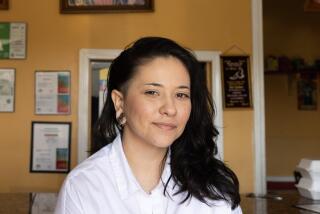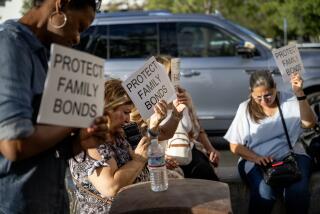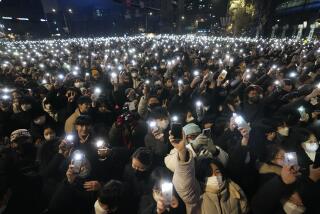Relatively Speaking
- Share via
“We are not old ladies!” snapped Aunt Toni, who may be 75 years old but is still the baby of what used to be a force of 14 brothers and sisters, the centerpiece of the Rynders family reunion, which recently drew more than 100 relatives to Chicago from as far as East Orange, N.J., and Orange County, Calif.
Aunt Toni had loved the idea of posing for pictures with four of her surviving sisters. But then the after-lunch photo session began to draw the attention of others. Things began to get gooey with sentiment and condescension. That’s when Aunt Toni spoke up, and her outburst brought a sudden stop to all the shutterbugging, as well as the oohing and ahhing.
Now, a little more softly, she repeated herself.
“We are not old ladies,” Aunt Toni said, still firm but starting to smile. “Look closely. We’re just little girls who have grandma faces.”
Family reunions are equal parts spiritual retreat, genealogical safari, old-fashioned potluck and weapons-grade plutonium shipment.
Convening for a few days with the far-flung tangents of our lineage holds the potential to lift us, teach us, nourish us or destroy our world as we know it.
“A family reunion presents us with situations we don’t encounter everyday,” says Marc Becker of Anaheim Hills, a practicing psychotherapist for 20 years. “Usually, people use the opportunity to recollect things that were exciting or fun or sentimental. But other things come up too, such as memories of when someone was embarrassed or got into trouble. Or unresolved differences. Or the feeling that somebody hasn’t measured up to expectations.”
The building blocks of our very identities are juxtaposed and examined and challenged at family reunions. We are compelled to consider the individual versus the group, ethno-culture versus socio-economics, unconditional love versus the unplucked hairs on great-auntie’s chin.
Year after year, however, family after family does it anyway.
*
Roughly 200,000 American families will congregate this year, according to Reunion Research, a San Francisco-based company that studies and promotes this tradition. Summer is the high season--with plenty planned for this very weekend.
More are conducted in the East than the West, owing both to the density of population and the pattern of American migration. The average reunion is two days, though the farther people must travel to attend, the longer a reunion tends to last. The average turnout is 40 people, which translates into an overall annual attendance of about 8 million.
“I’m a real stickler for stats,” understates Tom Ninkovich, who founded Reunion Research in 1971, fascinated with the subject after attending his 10-year high school reunion.
Ninkovich’s data do not include assaults, batteries, fatalities, lawsuits or the phone numbers of bail bondsmen. Most family reunions apparently come off without the commission of violent crime or the initiation of legal proceedings. But if looks could kill, if cutting comments really did draw blood, Ninkovich’s research also might bear occasional resemblance to a police blotter.
“When you go to a family reunion, you have the chance to find out why you look the way you look, why you speak and eat and dress the way you do, even why you think the way you think,” Ninkovich says. “To me, a family reunion is living anthropology, the telling of each person’s story through the family story.”
To help people climb their family trees, he has plowed his research into a book, “The Family Reunion Handbook.” The 226-page volume, now in its 10th printing, covers all aspects of reunion planning, from whipping up interest to tracking down family history to laying out a schedule to getting in under budget.
“It’s important to make these connections, hear the old stories, tell some ourselves, get some questions answered,” Ninkovich says. “The people we see at a reunion are the people we would be living with at an earlier time in history. The grandparents used to be the psychologists of our communities.”
A family reunion does pose the big questions: Who am I? Who are you? Who are they? Who’s the feeb who forgot to bring name tags? But profound answers are not guaranteed, no matter how intense or well-organized the event. Sometimes the best thing to come out of all this togetherness is an updated address book.
In fact, anybody who arrives at a family reunion expecting an immediately deep and comfortable reconnection with their roots probably has never attended one before. If a family is so large and dispersed as to require a ceremonial reunion, the first thing attendees are apt to realize is how many people they don’t recognize. Almost everybody has changed. Lots of others are complete strangers.
Let the small talk begin!
Conversations at family reunions often cull the current headlines, sitcoms and make frequent reference to the weather. Questions are scattershot, responses are edited carefully and observations rely heavily on knee-jerk cliches and vague philosophical truisms. You find yourself devising a safe summary of yourself that can be delivered before people’s eyes glaze over, then repeating it so often and to so many people that it is your eyes that eventually deaden.
There is good reason to exercise this kind of prudence.
A family reunion boils down to a party without a guest list. The people it gathers are often without common interests. The event is without many of the constraints of more formal interaction--because, after all, this is family. And it is loaded with intense consequences--because, after all, this is family! One false move and everybody’s suddenly staging a revival of “A Long Day’s Journey Into Night.”
But even from this superficiality, some value can be derived.
“Family reunions give people an opportunity to reconnect with others with whom they share an undeniable bond, even if it’s not in a very self-revealing way,” Becker says. “There is a sense of belonging, of membership in the same club, even though you may not really know them.”
*
Somewhere, right now, people are pumping a boy with embarrassment and pride by loudly remarking about how much he has grown.
They are picking out the resemblance between a little girl and a sepia-toned photograph of her long-dead grandmother. They are overlooking the gut spilling over an uncle’s belt to insist he hasn’t changed. They are exchanging recipes, organizing a tug-of-war, posing for snapshots. They are reminiscing and planning and regretting and resolving and arguing and forgiving. They are reviving the oldest and dearest and most democratic element of social interaction. They are having a family reunion.
“Of all social functions, family reunions have the most potential of changing things for the better,” Ninkovich says. “That’s because everyone is important at a family reunion. Everyone is necessary. Without everyone, the family just isn’t the family.”
More to Read
Sign up for Essential California
The most important California stories and recommendations in your inbox every morning.
You may occasionally receive promotional content from the Los Angeles Times.













